
Image courtesy NASA/Ball Aerospace
 Copyright © Michael Richmond.
This work is licensed under a Creative Commons License.
Copyright © Michael Richmond.
This work is licensed under a Creative Commons License.
Kepler was NASA's first mission devoted to the search for exoplanets via the transit technique. The idea was to put a telescope in space, above the Earth's atmosphere, in order to make very, very precise measurements of stellar brightness -- because only measurements at the level of 0.01 percent or better can show evidence for Earth-size planets orbiting Sun-size stars.
Kepler's mirror was relatively small: about 1.4 meters in diameter.

Image courtesy
NASA/Ball Aerospace
That mirror would focus light which had passed through a lens 0.95 meters in diameter, placing stellar images onto a camera sitting in the middle of the telescope.
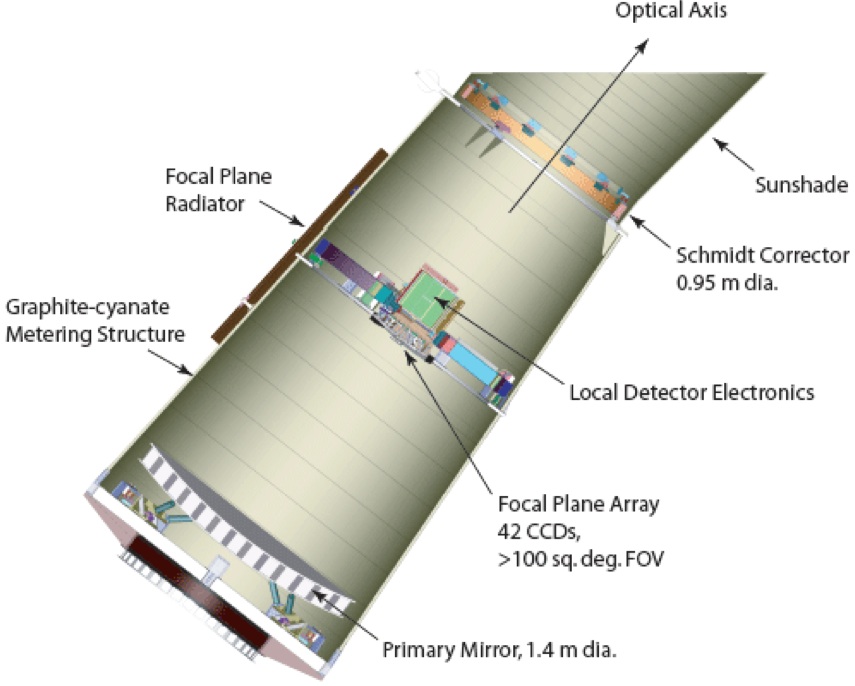
Image courtesy of
NASA
The entire package was part of a satellite about the size of a truck.
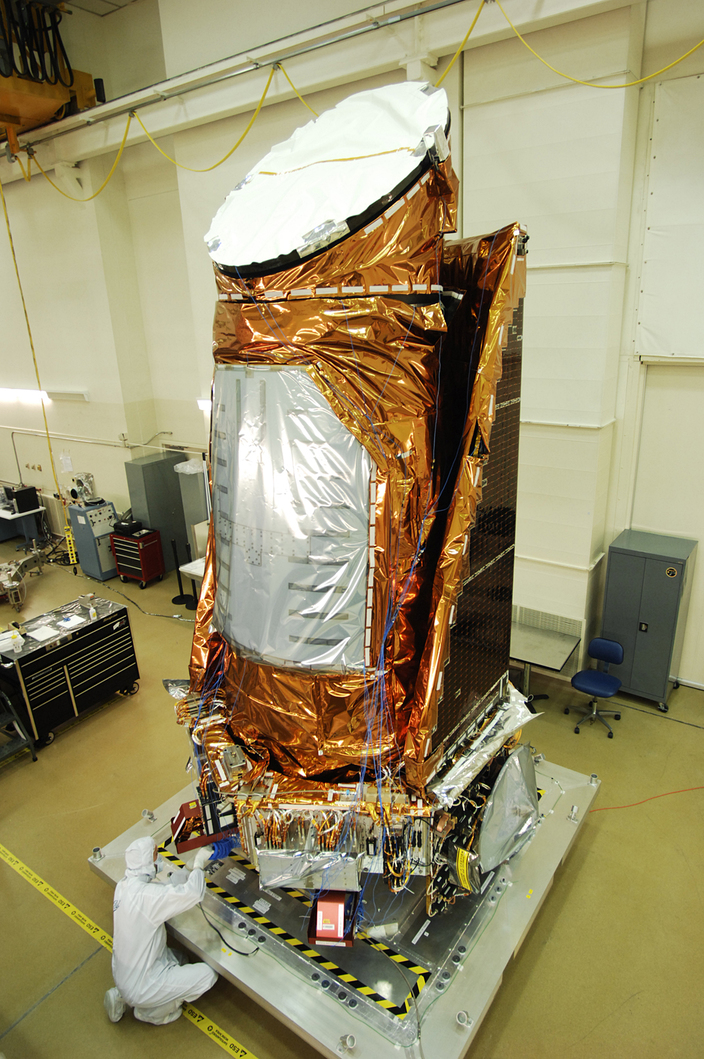
Image courtesy of
NASA Ames/Ball Aerospace
Kepler's camera contained 42 CCD chips, covering an area of on the sky of about 16x16 degrees -- inside of which might be tens of thousands of stars.

Image courtesy of
NASA/Ames/J. Jenkins
Kepler was designed to point at one location in space, taking pictures over and over and over for THREE YEARS.
Q: Why was 3 years chosen as the mission lifetime?
(Hint: how long would it take for you to detect
the Earth via the transit technique?)
In order to maximize the number of planets found over the course of its mission, Kepler pointed at a region which contained lots of stars: a section of the sky close to the Milky Way.
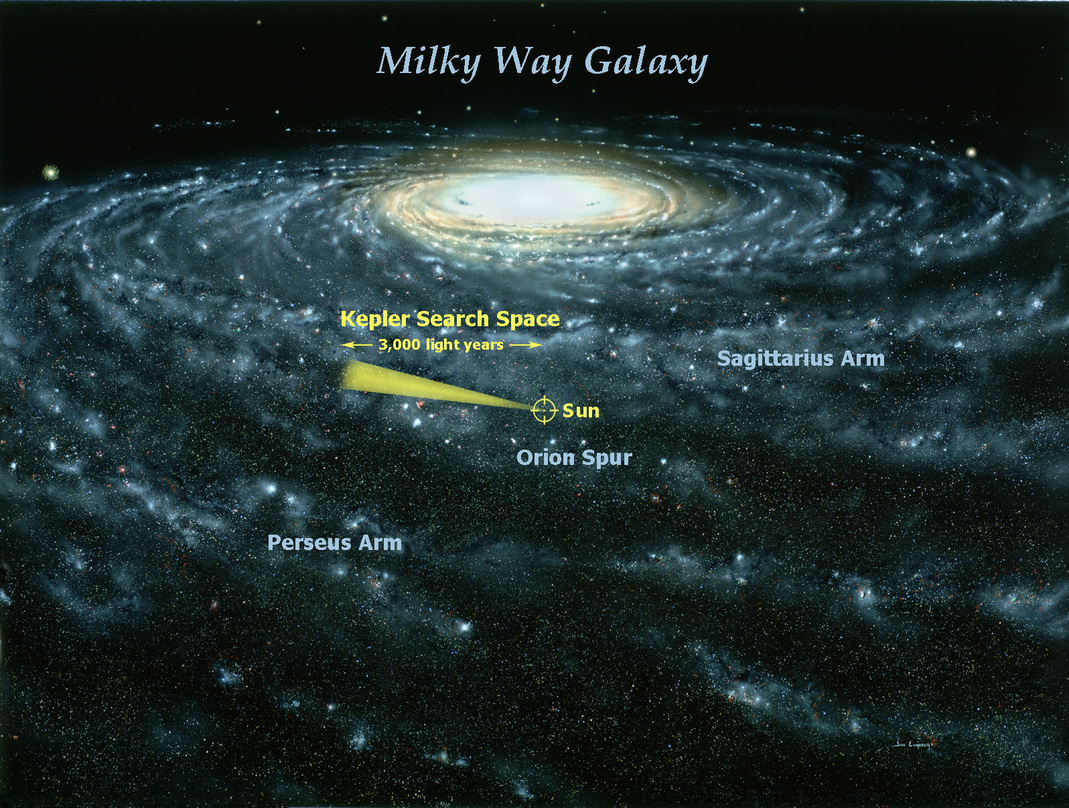
Painting copyright
Jon Lomberg
and adapted for Kepler mission;
courtesy of
Wikimedia
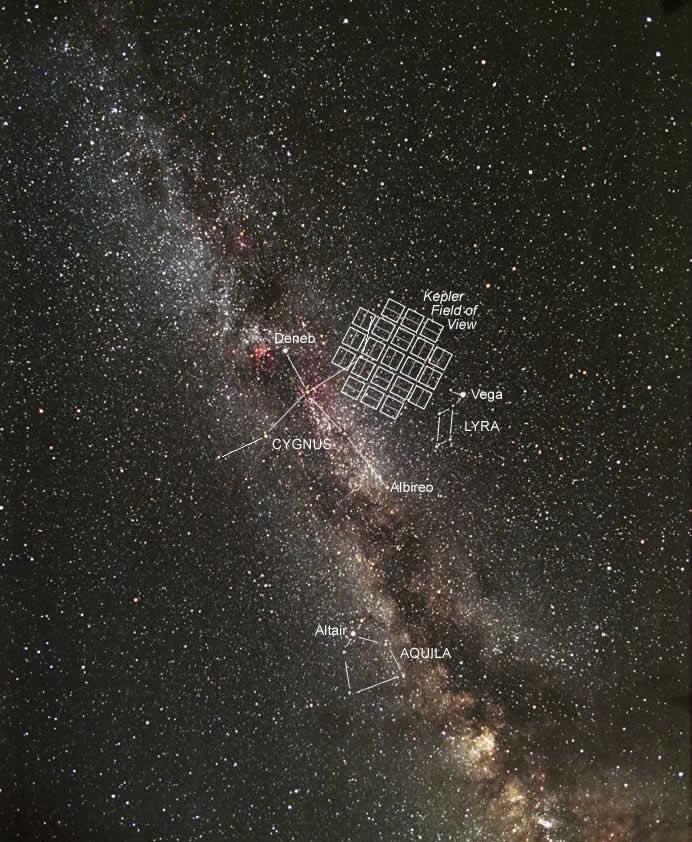
Image courtesy of
NASA / Carter Roberts / Eastbay Astronomical Society / Planetary Society
How precise were Kepler's measurements? Take a look at this set of sample light curves of stars which don't have planets. You can see how deep the transit by an Earth-sized planet would appear in the lower-left corner.

Image _probably_ taken from
Gilliland et al., AAS 215, 305.04, (2010)
The uncertainties in these measurements are roughly
uncertainty approx 10 parts per million (ppm) = 10-5
Remember that the transit by an Earth-sized planet passing in front of a Sun-sized star would block
2 2
( Earth radius ) ( 6.37 x 103 km )
( ------------ ) = ( ------------ ) = 8 x 10-5
( Sun radius ) ( 6.96 x 105 km )
In other words, Kepler ought to have detected Earth-sized planets, if they were present.
So, what did Kepler find? Before Kepler was launched, the number of transiting exoplanets was relatively small; not a single planet as small as the Earth had been found by this method.
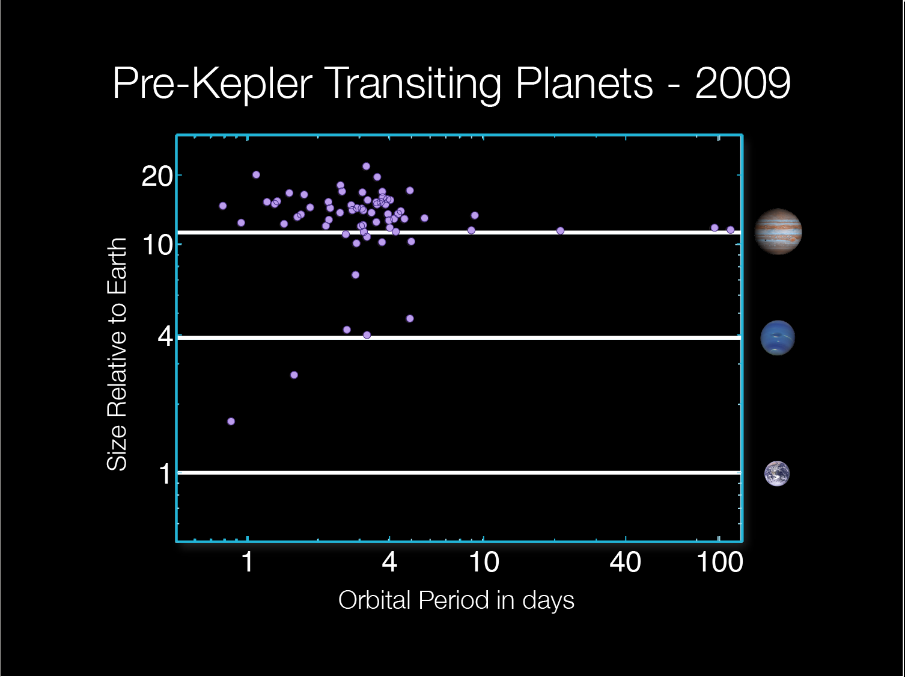
Image courtesy of
NASA Spaceflight.com
In 2017, near the end of the Kepler mission, the situation had changed quite a bit.

Image courtesy of
NASA/Ames Research Center/Wendy Stenzel
Q: How many of these planets are very similar to the Earth?
When the Kepler satellite was de-commissioned in Oct, 2018, the final count of planets (or planetary candidates) discovered by the mission was somewhere above 5,000.
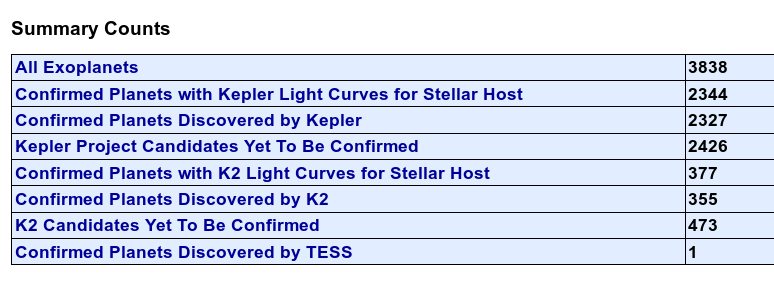
Table taken on Nov 19, 2018, from
NASA Exoplanet Archive
So, in every way, Kepler was a rousing success. Will the next satellite designed to find transiting planets be able to measure up?
The followup to Kepler is the Transiting Exoplanet Survey Satellite (TESS). Like Kepler, it is a relatively simple, low-cost space mission:
In some ways, TESS is "local" project from a single institution: MIT is leading the project.
Like Kepler, TESS is designed to take pictures of thousands of stars at once, and to measure the light of each one very precisely. The goal is the same: to find exoplanets by detecting the small, short, dips in brightness they cause as they pass in front of their host stars. But TESS takes a slightly different approach.
For example, instead of using a big (95 cm), mirror-based telescope, TESS uses a smaller (10.5 cm), lens-based telescope. Those of you who are photographers might want to compare this to your equipment: it's equivalent to a 147 mm f/1.4 lens.
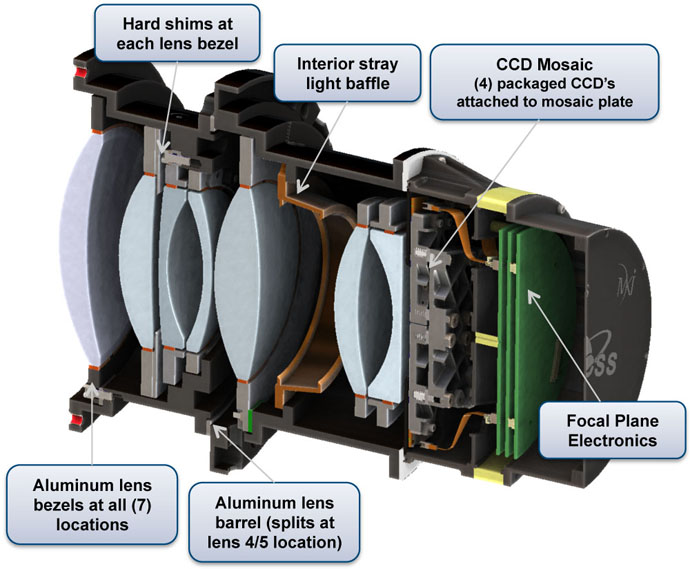
Image courtesy of
NASA
But TESS includes four telescopes, not just one. The four are pointed in different directions, so that their fields of view (24 x 24 degrees each) just barely overlap.

Image courtesy of
NASA's Goddard Space Flight Center
The combination of four telescopes means that TESS takes pictures of a long, "vertical" strip of sky, 24 degrees wide by 96 degrees tall. There are four CCD detectors in a mosaic sitting behind each of the telescopes, so a single snapshot looks something like this:
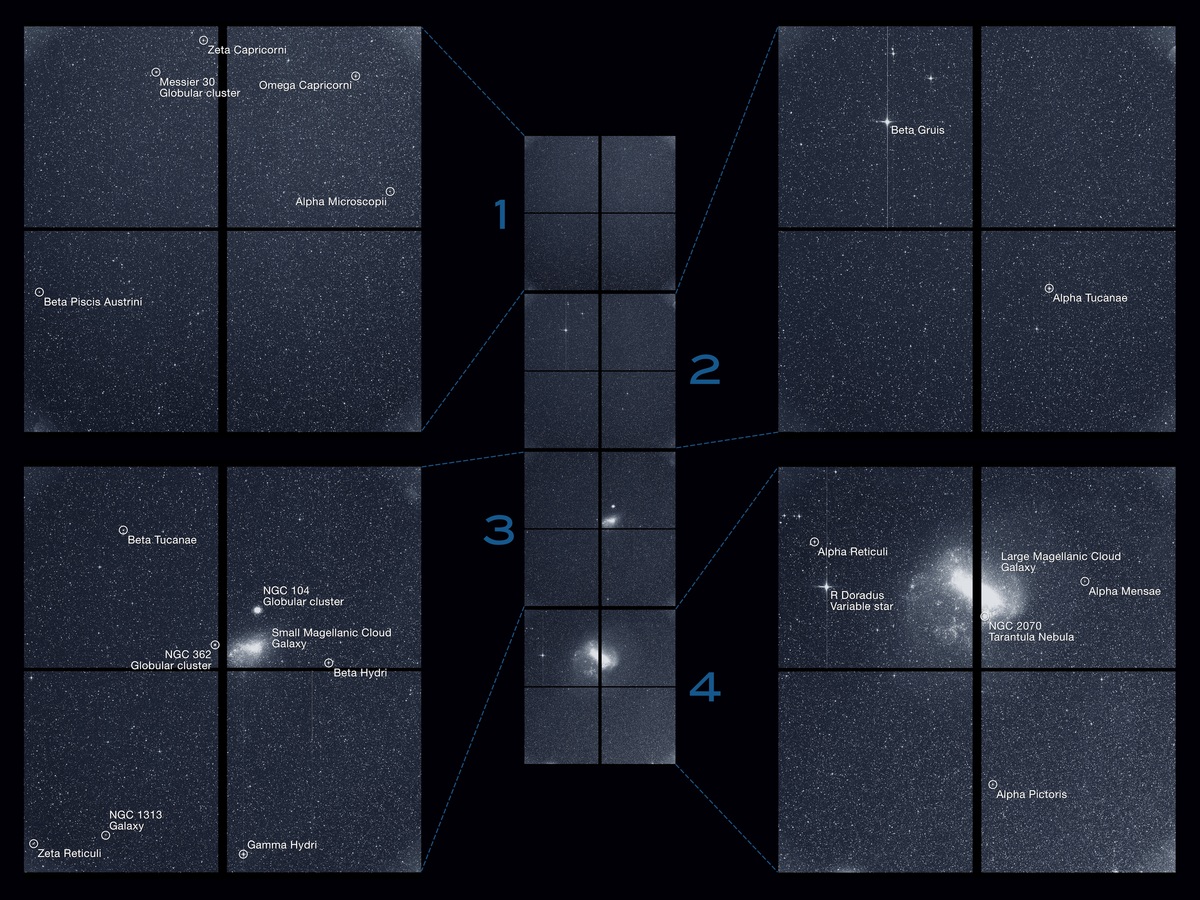
Image courtesy of
NASA/MIT/TESS
You may recall that Kepler's camera had 42 CCD chips, so the 16 inside TESS might seem like a step backwards. However, each of TESS's chips has 2048x2048 pixels, rather than 2200x1024 pixels. In the end, each TESS "snapshot" will contain 67 million pixels, about two-thirds of the 95 million in a single Kepler image.
That would add up to a rather unwieldy heap of information to send back to Earth: 67 million pixels times 2 bytes per pixel would equal 134 megabytes per image. And since the cameras are read out every 2 seconds, that would mean 67 megabytes per second of information. Yikes!
In order to reduce the amount of data, computers on board the spacecraft process the short 2-second images in two different ways to create a much smaller data volume.
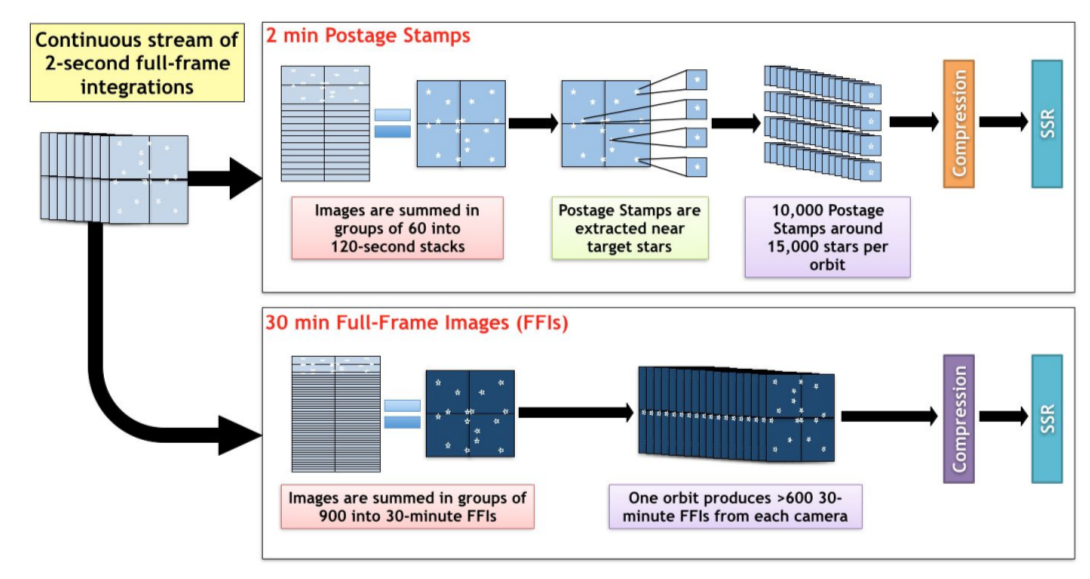
Image taken from
TESS Observatory Guide
This two-track processing means that, by the end of the two-year mission, scientists will have very detailed measurements of about 200,000 stars in the pre-chosen category, and somewhat less frequent measurements of EVERYTHING that falls into the field of view.
Kepler, as you may recall, stared at a single region of the sky, over and over, for more than three years.
TESS, on the other hand, is going to take a more active role. Instead of staring at one region of the sky, TESS will shift its view periodically -- about once every 4 weeks -- so that over the course of two years, it gradually observes (almost) the entire sky.

Image taken from
TESS Observatory Guide
This strategy means that some regions of the sky -- the ones close to the ecliptic poles -- will be observed almost continuously for a whole year. Other areas will get more than their fair share of time as well.
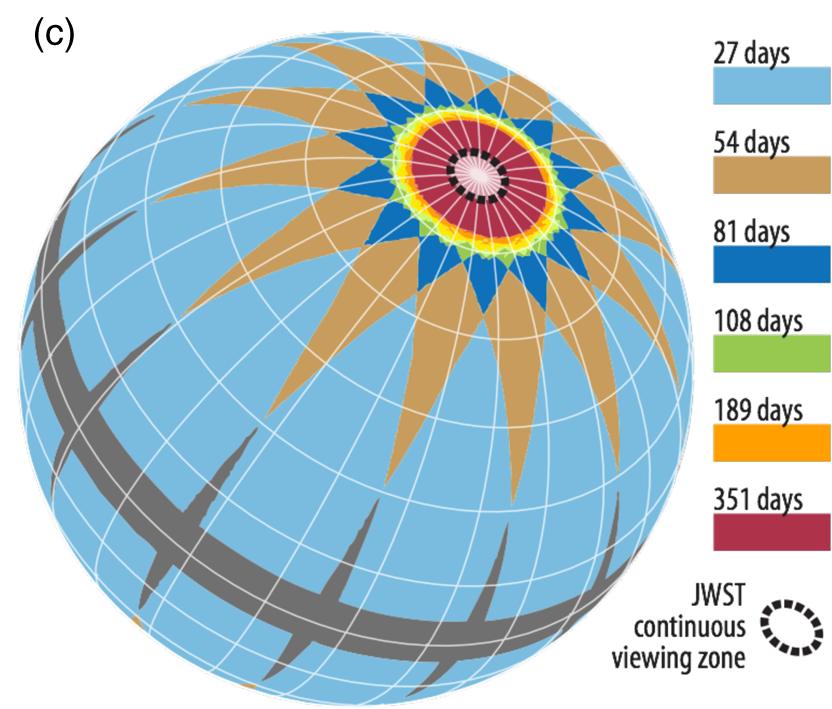
Image taken from
TESS Observatory Guide
Where will TESS live and work in space? Its orbit is a bit unusual: neither Low Earth Orbit (LEO), like the Hubble Space Telescope, nor geosynchronous, like weather satellites. Instead, it will take a long, eccentric path which reaches almost as far away as the Moon. Every 13.7 days, when it passes close to the Earth (LAHO in figure below), it will transmit data to ground stations.
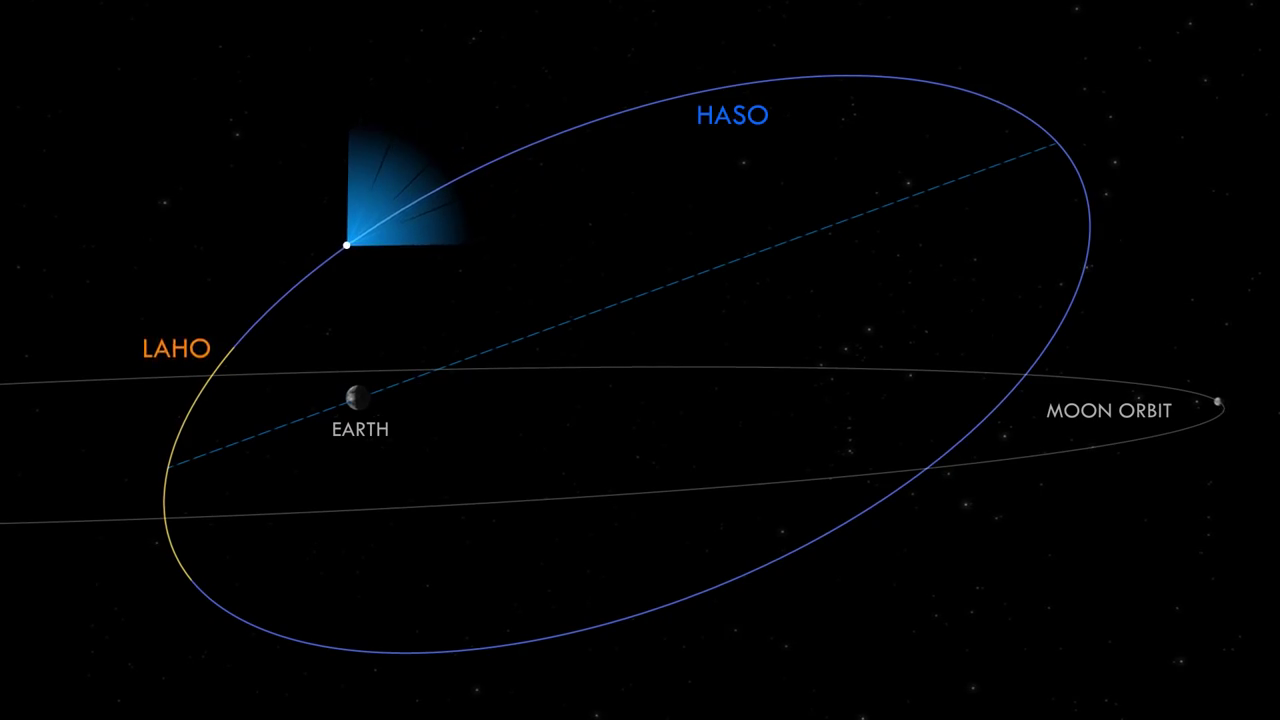
Image courtesy of some place like
NASA
TESS was launched on April 18, 2018, and started its science observations, covering the southern ecliptic hemisphere, on July 25, 2018. Roughly one year later, in July, 2019, the spacecraft will flip itself and start to observe the northern ecliptic hemisphere. If all goes well, the primary mission will end around July, 2020.
The name of the game is to measure the light curve of hundreds of thousands of stars very precisely, so that any little dips due to the transit of a planet will stand out clearly. Kepler set quite a high standard: the uncertainty in a single measurement for a bright star was only about 10 parts per million, or 0.001 percent.
Will TESS live up to that standard?
In a word, no. Because its telescopes are smaller than Kepler's, TESS cannot collect as much light as its older brother. That means that each of its measurements will have a lower precision: perhaps 200 parts per million for a bright star.
However, keep in mind that a typical planetary transit lasts for several hours, while TESS makes one measurement every two minutes. So, if scientists average together a number of consecutive measurements, they can reduce the noise considerably. The figure below shows the theoretical uncertainty in a one-hour average of measurements for stars both bright and faint. The goal is to reach about 60 ppm, over the course of an hour.

Image taken from
TESS Observatory Guide
Q: If TESS reaches the goal of 60 parts per million, averaged
over an hour, will it be able to detect an Earth-sized
planet passing in front of a Sun-sized star?
Let's look at an example of some real TESS data. You can browse through the data which has been released by the team at
I grabbed the measurements for the star known as WASP 100 (named after the team which first discovered it: Wide Angle Search for Planets = WASP), and picked out two little bits of data:
The result is a text file with two columns, arranged like so:
1325.2947715 11278.0750000 1325.2961604 11247.9550000 1325.2975493 11250.3000000
If we simply plot brightness versus time, we don't see all that much:
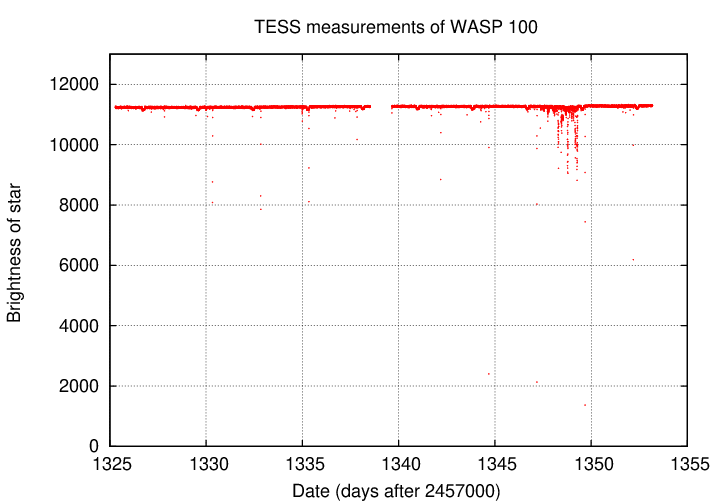
However, if we zoom in on the vertical axis, so that we plot only the measurements close to the maximum brightness, we see some features:
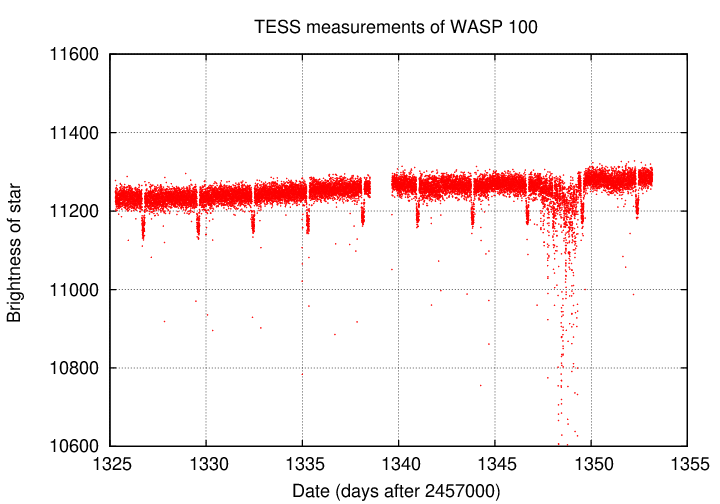
Q: Can you figure out the PERIOD of the planet's orbit?
It will be easier to perform some later analysis if we convert the measurements of brightness into "brightness relative to the average value." I'll pick an average of 11,250. We compute
brightness of each measurement
relative brightness = --------------------------------
average brightness
brightness of each measurement
= --------------------------------
11,250
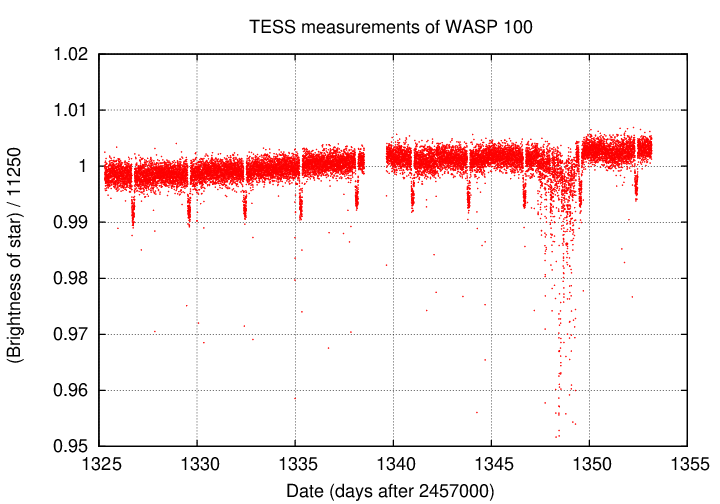

Q: Can you figure out the DEPTH of the transit?
Let's assume that the star is the same size as our Sun.
How large is the planet creating these transits?
What planet(s) does it resemble in our own Solar System?
If we look at a single transit in detail, we might see features of the dip which can tell us about the properties of the planet: does it have a thick atmosphere, or none at all? Little "bumps" in the dip might reveal the presence of a moon around the planet.
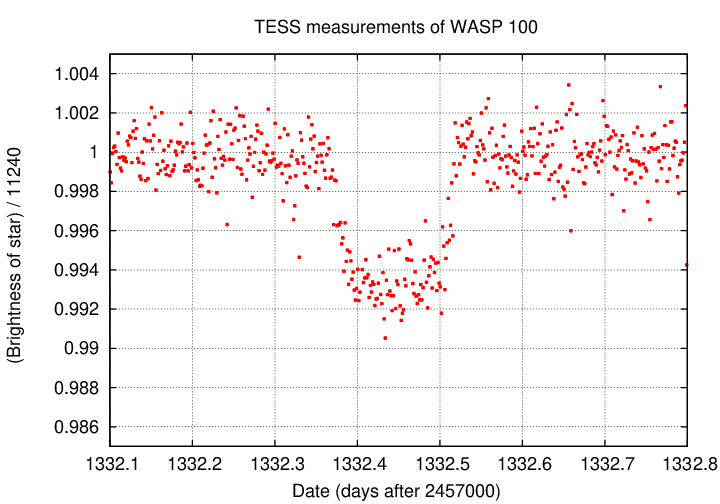
Q: What is the duration of this transit? In other words,
how long does the transit last? Express your answer
in hours.
If we assume that the star in this system is similar to our Sun -- in particular, if we assume that it has the same mass as our Sun -- then we can figure out the size of the orbit of this extrasolar planet. Remember what Mr. Kepler told us?

Q: What is the semi-major axis of this planet's orbit?
Express your answer in AU
Now that we know the distance between the planet and its star, we can estimate the temperature of the planet.

Q: What is the temperature of this planet?
Does this planet, WASP-100 b, sound like a good place to visit?
 Copyright © Michael Richmond.
This work is licensed under a Creative Commons License.
Copyright © Michael Richmond.
This work is licensed under a Creative Commons License.